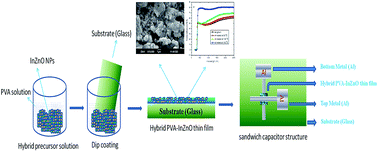Novel hybrid PVA–InZnO transparent thin films and sandwich capacitor structure by dip coating method: preparation and characterizations
Abstract
Novel hybrid poly(vinyl alcohol)–indium zinc oxide (PVA–InZnO) thin films were prepared by a simple and cost effective dip coating method and Al/PVA–InZnO/Al sandwich capacitor structure was prepared by using thermal evaporation and dip coating methods. Fourier transform infrared spectra showed the characteristic peaks correspond to metal–oxide bonds present in the films. The X-ray diffraction patterns revealed the existence of mixed phase cubic In2O3 and hexagonal wurtzite ZnO with polycrystalline structure. The scanning electron microscope images showed uniform distribution of In2O3 and ZnO nanoparticles over the entire film surface. High transmittance (50 to 80%), low absorbance, wide band gap energy (4.1 to 3.75 eV) and low α and k were obtained from an optical study. High dielectric constant, low dielectric loss and low activation energy were obtained from Al/PVA–InZnO/Al. The obtained results suggested that these prepared hybrid thin films could be used as hybrid gate dielectric layer in transparent organic thin film transistors (T-OTFT's) and in opto-electronic devices in the near future.


 Please wait while we load your content...
Please wait while we load your content...